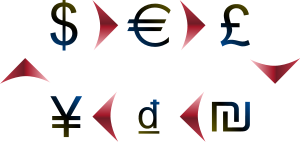 Image via Wikipedia
Image via WikipediaForex autotrading is a trading strategy where buy and sell orders are placed automatically based on an underlying system or program on the foreign exchange market. The buy or sell orders are sent out to be executed in the market when a certain set of criteria is met.
Autotrading systems, or programs to form buy and sell signals, are used typically by active traders who enter and exit positions more frequently than the average investor. The autotrading criteria differ greatly, however they are mostly based on technical analysis.[1]
Contents [hide]
1 History
2 Types
2.1 Advantages
2.2 Disadvantages
3 See also
4 References
[edit]History
Forex autotrading originates at the emergence of online retail trading, since about 1999 when internet-based companies created retail forex platforms that provide a quick way for individuals to buy and sell on the forex spot market. Nevertheless, larger retail traders could autotrade Forex contracts at the Chicago Mercantile Exchange as early as in the 1970s.
[edit]Types
There are two major types of Forex autotrading:
Fully automated or robotic Forex trading: This is very similar to algorithmic trading or black-box trading, where a computer algorithm decides on aspects of the order such as the timing, price or quantity and initiates the order automatically. Users can only interfere by tweaking the technical parameters of the program; all other control is handed over to the program.[citation needed]
Signal-based Forex autotrading: This autotrading mode is based on manually executing orders generated by a trading system. For example a typical approach is to use a service where traders all over the world making their strategies available to anyone interested in the form of signals. Traders may choose to manually execute any of these signals in their own broker accounts.[citation needed]
[edit]Advantages
An automated trading environment can generate more trades per market than a human trader can handle and can replicate its actions across multiple markets and timeframes. An automated system is also unaffected by the psychological swings that human traders are prey to. This is particularly relevant when trading with a mechanical model, which is typically developed on the assumption that all the trade entries flagged will actually be taken in real time trading.[2]
Signal Provider based models offer traders the opportunity to follow previously successful signal providers or strategies with the hope that the advice they offer will continue to be accurate and lead to profitable future trades. Traders do not need to have expert knowledge or ability to define their own strategies and instead can select a system based on its performance to date, making Forex trading accessible to a large number of people.
[edit]Disadvantages
As a decentralized and relatively unregulated market, it is extremely attractive to a number of Forex scams. Forex autotrading, as it brings Forex trading to the masses makes even more people susceptible to frauds. Bodies such as the National Futures Association and the U.S. Securities and Exchange Commission have issued warnings and rules to avoid fraudulent Forex trading behavior.[3]

No comments:
Post a Comment